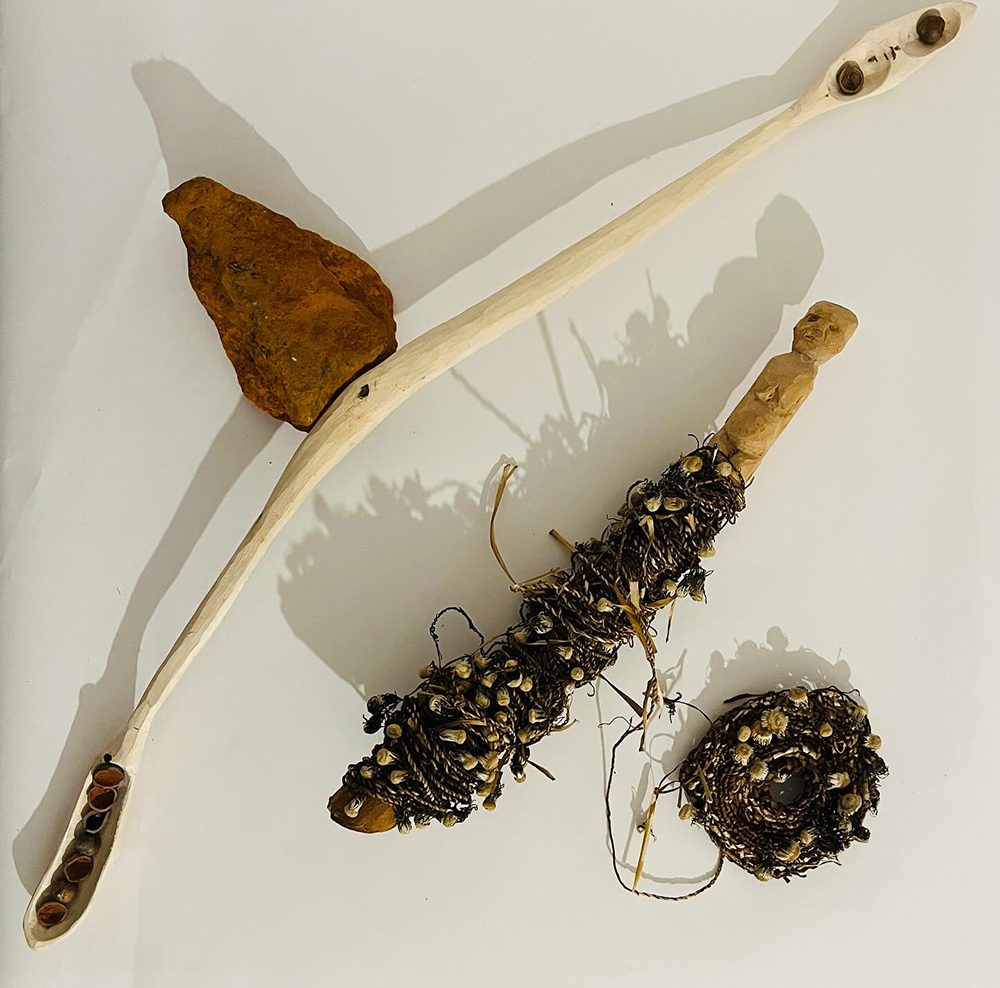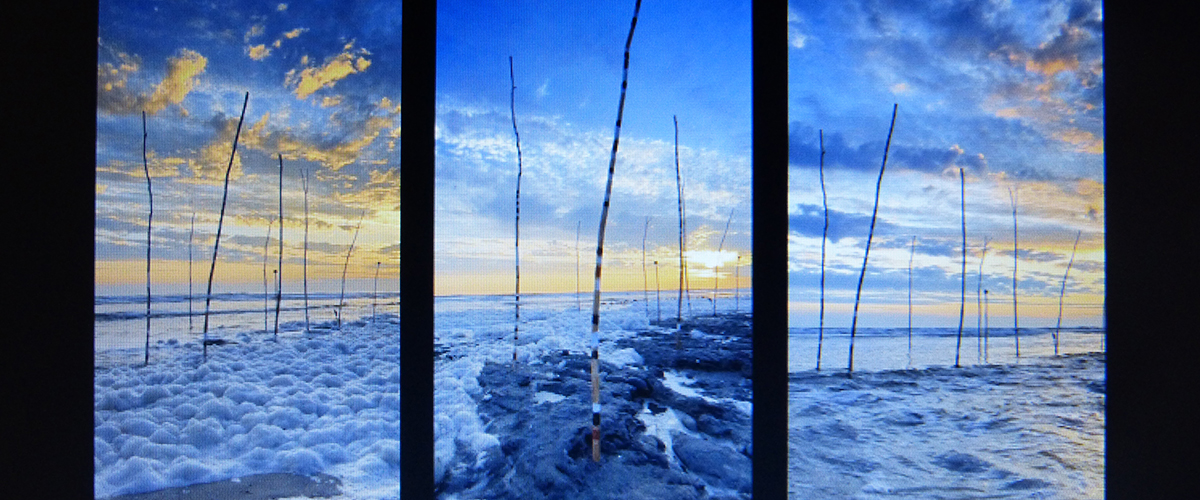The Walking Women exhibition was a project brought together by Carys Wilson and shown at Falmouth Art Gallery, Uk.
Nine Hazel Sticks was a collaborative land art intervention working alongside and supported by the artist Pauline Woolley. Pauline's award winning works often relate to the night sky and solar imagery. Here is the film of my performance & temporary intervention curated by Pauline Woolley.
This was the start of my third and final exploration walking the Ceredigion coast, this time between Borth and Ynslas Coastal Nature Reserve.
Borth beach has one of the best preserved ancient submerged forests in the UK. I helped Archaeologist Dr Martin Bates take an auger sample of the deep marine clay and peat sediments. The project developed from a child's question. How long would a hazel pole stand upright in this intertidal zone of exposed clay?
Hazelnuts have been harvested since the Mesolithic 9,000 years ago. Stone-lined pits filled with over 100,000 burned hazelnut shells have been discovered dating to 6000 BCE.
In Celtic mythology there are ancient tales of a sacred pool, the well of wisdom where nine hazelnut trees grew. This marked the border with the otherworld. The hazel nut is meant to be imbued with mystical wisdom and prophetic knowledge. Also the druids, Greek and Roman gods were aided by the protection of a hazel staff when travelling between worlds.
Painting each hazel pole with egg tempera and setting them deep in the archive of clay yet pointing to the vast night sky became a sacred act. By using materials of myth and the Mesolithic like Hazel, red ochre, chalk and charcoal I made temporal connections of time, place, culture and material linking Ireland and Wales.
They became tidal gauges and human support, marking the liminal intertidal space and the horizon line as earth turned, sun retreated and moon rose. The ephemeral nature of the works and the emphasis on change, flow and flux above us, within us and all the space between made this an extremely emotive and exciting experience. Locals and tourists interacting with the process and in conversation became custodians of the work. They kept me updated on how many sticks survived the stormy weather and each high tide, documenting the process for me. The sticks were not washed up at the site and no physical trace of the work remains.
This project highlighted the potential for the public to become stewards and custodians of temporary, experimental, and site-specific artworks. It shed light on the evolving, temporal nature of land art works. It demonstrated how a community can interact and respond to changes in their environment. This collaborative effort not only expanded my vision but contributed to broad conversation about the role of art, sustainability, and public engagement in climate mitigation.
 "
"
Mesolithic Mother - Double ended hazel spoon, Ochre rock, mouse nibbled hazelnuts & Dandelion Cordage
The dandelion cordage was made as the precursor to this 3 part European funded Portalis project. I was tuning into the season with the dandelion clocks marking time. One of my boys asked if there were dandelions in the Mesolithic and after more initial research, yes there were. I walked 20 miles from Cors Caron raised peat bog below the Teifi Mountains where the Irish Ice sheet met the Welsh. I counted the chain for mothers back to the Mesolithic with cordage made from dandelion. The famine food. I followed the Ystwyth river to it's mouth in an attempt to find my way back to the Mesolithic mothers and their watery world. Flints, hazel and ochre were materials linking the present and past along the way. Willow fluff filled the air and the post mining landscape and abandoned train route lead me back to the climate fuelled questions paramount to this project. For more on the Temporary land interventions I was commissioned to produce take a look at my Portalis project page.
Nine Hazel Sticks was a collaborative land art intervention working alongside and supported by the artist Pauline Woolley. Pauline's award winning works often relate to the night sky and solar imagery. Here is the film of my performance & temporary intervention curated by Pauline Woolley.
This was the start of my third and final exploration walking the Ceredigion coast, this time between Borth and Ynslas Coastal Nature Reserve.
Borth beach has one of the best preserved ancient submerged forests in the UK. I helped Archaeologist Dr Martin Bates take an auger sample of the deep marine clay and peat sediments. The project developed from a child's question. How long would a hazel pole stand upright in this intertidal zone of exposed clay?
Hazelnuts have been harvested since the Mesolithic 9,000 years ago. Stone-lined pits filled with over 100,000 burned hazelnut shells have been discovered dating to 6000 BCE.
In Celtic mythology there are ancient tales of a sacred pool, the well of wisdom where nine hazelnut trees grew. This marked the border with the otherworld. The hazel nut is meant to be imbued with mystical wisdom and prophetic knowledge. Also the druids, Greek and Roman gods were aided by the protection of a hazel staff when travelling between worlds.
Painting each hazel pole with egg tempera and setting them deep in the archive of clay yet pointing to the vast night sky became a sacred act. By using materials of myth and the Mesolithic like Hazel, red ochre, chalk and charcoal I made temporal connections of time, place, culture and material linking Ireland and Wales.
They became tidal gauges and human support, marking the liminal intertidal space and the horizon line as earth turned, sun retreated and moon rose. The ephemeral nature of the works and the emphasis on change, flow and flux above us, within us and all the space between made this an extremely emotive and exciting experience. Locals and tourists interacting with the process and in conversation became custodians of the work. They kept me updated on how many sticks survived the stormy weather and each high tide, documenting the process for me. The sticks were not washed up at the site and no physical trace of the work remains.
This project highlighted the potential for the public to become stewards and custodians of temporary, experimental, and site-specific artworks. It shed light on the evolving, temporal nature of land art works. It demonstrated how a community can interact and respond to changes in their environment. This collaborative effort not only expanded my vision but contributed to broad conversation about the role of art, sustainability, and public engagement in climate mitigation.
 "
" Mesolithic Mother - Double ended hazel spoon, Ochre rock, mouse nibbled hazelnuts & Dandelion Cordage
The dandelion cordage was made as the precursor to this 3 part European funded Portalis project. I was tuning into the season with the dandelion clocks marking time. One of my boys asked if there were dandelions in the Mesolithic and after more initial research, yes there were. I walked 20 miles from Cors Caron raised peat bog below the Teifi Mountains where the Irish Ice sheet met the Welsh. I counted the chain for mothers back to the Mesolithic with cordage made from dandelion. The famine food. I followed the Ystwyth river to it's mouth in an attempt to find my way back to the Mesolithic mothers and their watery world. Flints, hazel and ochre were materials linking the present and past along the way. Willow fluff filled the air and the post mining landscape and abandoned train route lead me back to the climate fuelled questions paramount to this project. For more on the Temporary land interventions I was commissioned to produce take a look at my Portalis project page.
